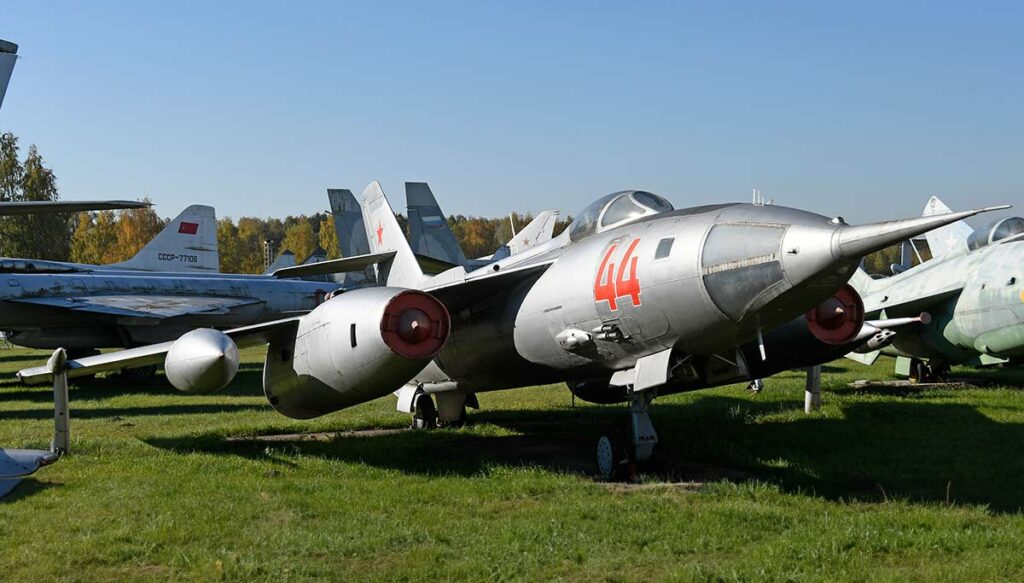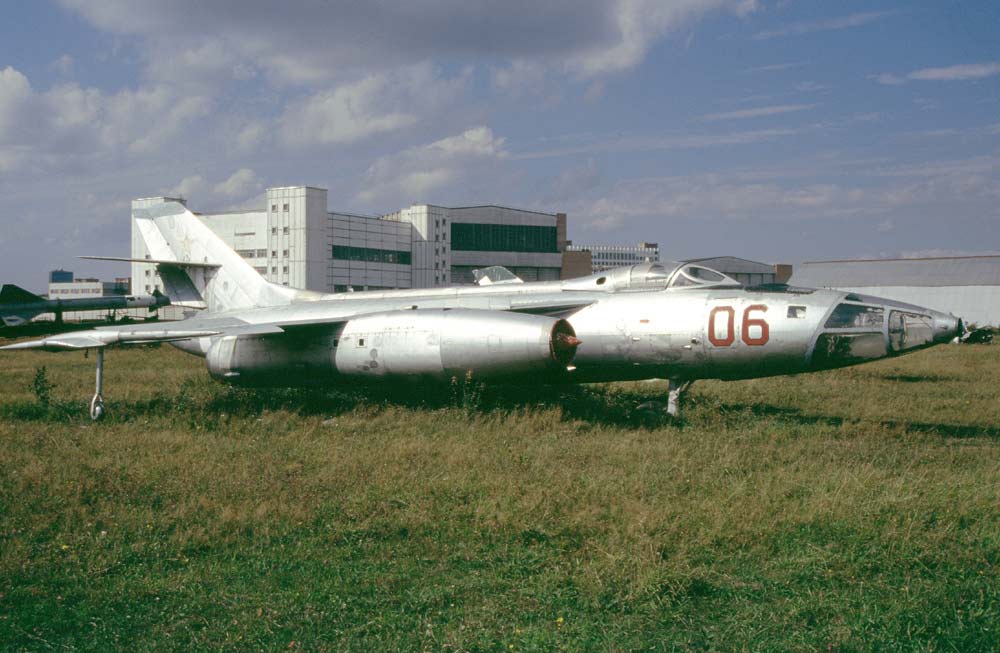The Yakovlev Yak-28 (Brewer/Firebar) was a Soviet twin-engine, supersonic bomber and reconnaissance aircraft from the Cold War era, known for its versatility and range.
In brief
The Yakovlev Yak-28, known to NATO as the Brewer (bomber versions) and Firebar (reconnaissance versions), is a significant Cold War era aircraft. Designed by the Soviet Union’s Yakovlev design bureau in the late 1950s, it was a versatile platform serving in various roles, including bomber, reconnaissance, interceptor, and electronic warfare. Its twin turbojet engines, mounted in the fuselage with distinctive air intakes above the wing roots, enabled it to achieve supersonic speeds. The aircraft featured a variable-geometry air intake system, which was quite advanced for its time, and it was one of the first Soviet bombers capable of carrying nuclear weapons. The Yak-28 had a crew of two and was notable for its bicycle landing gear configuration, which included outrigger wheels in the wings to maintain stability on the ground.

Introduction
The Yakovlev Yak-28, a product of the intense Cold War period, represents a pivotal step in Soviet aviation technology. Developed to meet the Soviet Air Force’s demand for a versatile, high-speed, and long-range aircraft, the Yak-28 played a crucial role in projecting Soviet aerial capabilities during its service life.
History of the Development
The development of the Yakovlev Yak-28 began in the mid-1950s, a period marked by rapid advancements in military technology and escalating tensions between the NATO and Warsaw Pact countries. The Soviet Union, recognizing the need to modernize its air force and counter Western air superiority, initiated the Yak-28 program to develop a multi-role aircraft capable of performing strategic bombing, reconnaissance, and electronic warfare missions.
The Yakovlev design bureau, led by Alexander Sergeyevich Yakovlev, was tasked with this ambitious project. The design aimed to incorporate the latest in jet technology, including powerful new engines and aerodynamic innovations, to create an aircraft that could operate at supersonic speeds, deliver nuclear payloads, and perform long-range reconnaissance missions.
The Yak-28 made its maiden flight on March 5, 1958, showcasing the potential to meet the Soviet Air Force’s diverse operational requirements. The NATO reporting name “Brewer” for the bomber variant and “Firebar” for the reconnaissance variant highlighted the aircraft’s perceived threat and capabilities by Western intelligence.
The designation of NATO nicknames, such as Brewer and Firebar, served as part of a systematic approach to identify and classify Soviet aircraft. These names, often chosen to start with the same letter as the Soviet designation (in this case, ‘B’ for bomber variants), provided a shorthand for referring to enemy aircraft in intelligence and operational contexts.
Design of the Yakovlev Yak-28
The design of the Yak-28 was a testament to Soviet engineering ingenuity during the Cold War. Measuring approximately 21.6 meters in length with a wingspan of 11.6 meters, and standing 3.9 meters tall, the aircraft was built to fulfill a variety of roles. Its twin Tumansky R-11 turbojet engines, each producing up to 8,700 kilograms of thrust with afterburners, were a key feature, enabling a maximum speed of Mach 1.3 (approximately 1,000 mph or 1,600 km/h) and a service ceiling of 45,000 feet (13,716 meters).
The Yak-28’s range was notable, with a combat radius exceeding 1,200 miles (1,930 kilometers), thanks to its efficient engine design and substantial fuel capacity. The aircraft’s payload capacity allowed it to carry a variety of weapons, including conventional bombs, nuclear missiles, and later, advanced electronic warfare equipment.
One of the unique aspects of the Yak-28 was its landing gear configuration. The main gear was a bicycle-type arrangement with two large wheels under the fuselage, complemented by smaller outrigger wheels mounted under each wing. This design was chosen to accommodate the large internal weapons bay and fuel tanks, but it also required pilots to have specialized training due to its unconventional takeoff and landing characteristics.
Performance of the Yakovlev Yak-28
The performance of the Yak-28 was competitive for its time, especially when compared to contemporaneous Western aircraft such as the U.S. B-58 Hustler. While the B-58 was faster, achieving speeds up to Mach 2, the Yak-28 offered greater versatility, being capable of fulfilling not just bombing but also reconnaissance and electronic warfare roles. Its operational ceiling and range made it a formidable asset for the Soviet Air Force, allowing it to penetrate deep into enemy territory while evading most ground-based air defenses of the era.
Variants of the Yakovlev Yak-28
Throughout its service life, the Yak-28 was developed into several variants to suit different military needs. The initial version, the Yak-28B (Brewer-A), was a tactical bomber. This was followed by the Yak-28P (Firebar), an all-weather interceptor equipped with radar-guided air-to-air missiles. Other notable variants included the Yak-28I (Brewer-C), an improved bomber with advanced avionics, and the Yak-28PP (Brewer-E), designed for electronic countermeasures and warfare. Each variant was tailored to specific roles, demonstrating the platform’s adaptability and versatility.

Military Use and Combat
The Yak-28 saw extensive service with the Soviet Air Force and several Warsaw Pact countries. It was deployed in various military exercises and stood as a critical component of the Soviet strategic bomber force during the Cold War. Although not extensively used in direct combat, the Yak-28’s presence and potential capabilities played a significant role in the strategic balance between NATO and the Warsaw Pact. Its reconnaissance variants provided valuable intelligence, while the electronic warfare models could jam enemy radar and communications, showcasing the aircraft’s strategic value beyond conventional bombing missions.
The Yak-28 was eventually phased out in favor of more modern aircraft, such as the MiG-25 and Su-24, which offered superior performance and versatility. However, its legacy as a multi-role aircraft that contributed significantly to the strength of the Soviet Air Force during the Cold War era remains.
The Yakovlev Yak-28 (Brewer/Firebar) stands as a testament to Soviet engineering during the Cold War. Its development and service highlighted the era’s technological race and the strategic emphasis on versatile, multi-role military assets. With its impressive range, speed, and payload capabilities, the Yak-28 played a crucial role in projecting Soviet power and deterring potential adversaries, embodying the complexities and challenges of aerial warfare during one of history’s most tense periods.
Back to the Fighter Jet section.